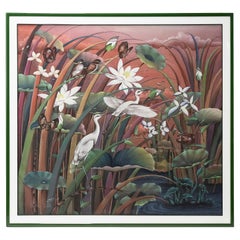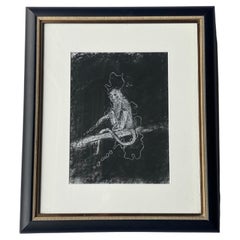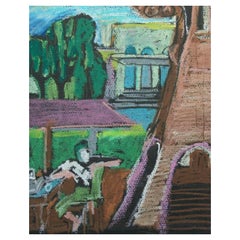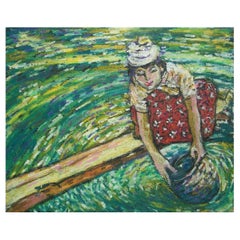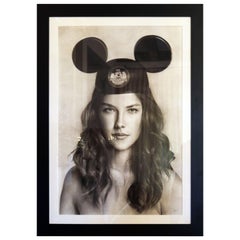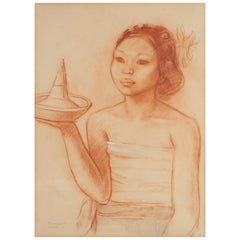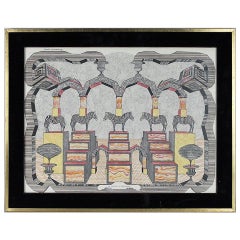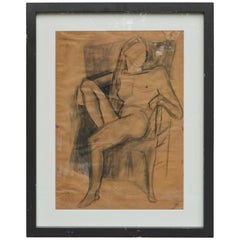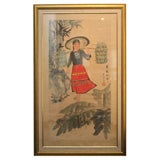Southeast Asian Drawings
to
4
1
6
1
Height
to
Width
to
2
6
1
2
4
4
2
2
2
1
24,372
1,136
617
511
508
7
7
7
1
Place of Origin: Southeast Asian
Large Vintage Asian Bali Art Painting signed J.Wikarma'90
Located in Vilnius, LT
Large Balinese art painting in oil on fabric with flowers and birds.
Frame in green lacquered wood.
Signed by the author: J.Wikarma'90.
Very good/excellent vintage condition.
Category
Late 20th Century Southeast Asian Drawings
Materials
Paint, Textile
Jose "Jojo" Legaspi Drawing, Charcoal on Paper, Framed
By José 'Jojo' Legaspi
Located in Los Angeles, CA
Nice sample of this series of the well known Philippine artist Jojo Legaspi , also master of drawing in charcoal .the image Zise is 8.5 x 11.75 inches , a...
Category
21st Century and Contemporary Post-Modern Southeast Asian Drawings
Materials
Paper
Aung Khin, Impressionist Oil Pastel Drawing, Unsigned, Myanmar, 20th Century
Located in Chatham, ON
AUNG KHIN (1921-1996) Attributed - vintage impressionist style oil pastel and colored graphite drawing on black paper - with another drawing verso - unsigned...
Category
Late 20th Century Modern Southeast Asian Drawings
Materials
Paper, Crayon
AUNG KHIN - Impressionist Oil Pastel Drawing - Unsigned - Myanmar - 20th Century
Located in Chatham, ON
AUNG KHIN (1921-1996) Attributed - Vintage Impressionist style oil pastel and graphite drawing on black paper - featuring a young a Burmese girl perched on a...
Category
Late 20th Century Modern Southeast Asian Drawings
Materials
Paper, Crayon
Nantawang "Mickey", 2010 Hyperrealist Drawing of Actress Alessandra Ambrosio
Located in Marbella, ES
Nantawant "Mickey", 2010 hyperrealist drawing of Brazilian model and actress Alessandra Ambrosio wearing a Mickey Mouse ear hat.
Dimensions with f...
Category
Late 20th Century Southeast Asian Drawings
Materials
Paper
Portrait of a Balinese Beauty by Theo Meier in Original Frame
Located in Amsterdam, NL
Theo Meier (1908-1982)
“A Balinese woman with offerings”
Signed, dated '36 and annotated Mankok (the name of the sitter) lower left
Sanguine on paper, measures: 57 x 41.5 cm
In a handmade and hand painted frame with address: Max Kno¨ll, Herberggasse 4/1, Basel.
Provenance:
Private collection, Basel (acquired directly from the artist)
Private collection, London
Note:
Theo Meier was born in Basel, where he attended art school and became a successful portrait painter. However, after visiting an exhibition in Basel of Tahitian paintings by Paul Gaugin, he decided to follow in Gaugin’s footsteps and go to the South Pacific. To finance his voyage, he founded a club in which every member pledged a monthly sum in return of which they could choose one of Meier’s paintings upon his return.
In 1932, at the age of 24, he embarked on his voyage to the South Sea. In Tahiti, he certainly discovered the beauty of the colours of the tropical world but the simplicity of the inhabitants, he had seen in Gaugin’s paintings turned out to be more in the artist’s fantasy than in reality. He returned to Basel but in 1935 again was on his way to the South Sea. In 1936 he arrived in Bali, planning to stay there for two or three weeks, but thirty years later he was still there. In Bali “a delirium laid hold of me which even today has not subsided”, he was to write much later. The present drawing was made during his first “delirius” year in Bali. In Bali, he settled and found inspiration and friendship with other artists including Walter Spies...
Category
Early 20th Century Dutch Colonial Southeast Asian Drawings
Materials
Other
Collection of Colonial Drawings Depicting Indonesia by J.G. Sinia '1875-1948'
Located in Amsterdam, NL
A Collection of Thirteen Ink and Chalk Drawings by Johan Gerard Sinia (1875-1948)
All framed in gilt-metal or giltwood frames
Sinia started his professional career as an army off...
Category
Early 20th Century Dutch Colonial Southeast Asian Drawings
Materials
Other
Related Items
Framed Surrealistic Drawing by Pedro Friedeberg
By Pedro Friedeberg
Located in Atlanta, GA
Artist: Pedro Friedeberg (Mexican, 1936-)
Title:Le Tombeau D'Hemingway
Year: 1963
Medium: Ink and watercolor on paper:
Size: 14 3/4 x 19 1/2 plus 3 inch frame
Mark: upper lef...
Category
1960s Modern Vintage Southeast Asian Drawings
Materials
Paper
Sitting Female Nude Sketch Painting, Signed 1974
Located in Haddonfield, NJ
20th Century Female Nude Sketch Painting In Black Frame, Signed 1974
Beautiful nude sketch of the female form signed and dated by the artist, 11...
Category
20th Century Mid-Century Modern Southeast Asian Drawings
Materials
Paper
Unknown Academy Student 19th C Drawing, Pencil on Paper, Framed, Signed
Located in Leuven , BE
Unknown academy student 19th C drawing, pencil on paper, Framed, Signed.
Category
19th Century Antique Southeast Asian Drawings
Materials
Paper
$718
H 29.53 in W 22.45 in D 1.97 in
19th C, Academy Student Drawing, Pencil on Paper
Located in Leuven , BE
Drawing is framed, signed and dated.
Category
19th Century Neoclassical Antique Southeast Asian Drawings
Materials
Paper
French Charcoal Drawing of Seated Nude, Circa 1910
Located in Los Angeles, CA
A charcoal drawing of an art model male nude in custom modern frame. During the Art Nouveau period emphasizing natural forms and structures.
Category
Early 20th Century Art Nouveau Southeast Asian Drawings
Materials
Parchment Paper
19th C, Drawing on Paper, Dated, Signed and Framed
Located in Leuven , BE
Unknown Academy Student 19th C Drawing, pencil on paper.
Category
19th Century Antique Southeast Asian Drawings
Materials
Paper
Serpent & Galleon, Red Chalk on Paper in GiltWood Frame
Located in Huntington, NY
Serpent & Galleon, Ink on Paper, in an
18th Century GiltWood Frame.
Category
17th Century Baroque Antique Southeast Asian Drawings
Materials
Giltwood, Paper
$3,840 Sale Price
20% Off
H 20.63 in W 24.63 in D 1.88 in
Framed Korean Official Portrait Joseon Dynasty
Located in Atlanta, GA
A hyper realistic portrait of an official with watercolor on silk bordered panel, framed in dark wood, from Korean late Joseon dynasty, circa 19th century. The beard man sitting with a formal frontal view, displays a benevolent facial expression, in keeping with the Confucius value of the officialdom at the time. He dons a black linen official hat and a blue silk robe...
Category
19th Century Other Antique Southeast Asian Drawings
Materials
Silk, Wood
Four Framed Pencil Signed and Numbered Etchings, Finely Framed and Matted
Located in Manhasset, NY
Four framed pencil Signed and Numbered Etchings. Finely framed and matted. A simply lovely group of wall decorations. Each hand drawn, signed and numb...
Category
1960s American Classical Vintage Southeast Asian Drawings
Materials
Glass, Wood, Paper
$1,600 / set
H 20.5 in W 15.5 in D 0.25 in
Mid-Century Balinese Painting on Silk with Bamboo and Woven Rattan Frame, 1960s
Located in Roma, IT
Spectacular large Balinese Painting on Silk with an outstanding bamboo and woven rattan frame. This marvellous painting was realized in Bali around the 1960s and is signed on the bot...
Category
Mid-20th Century Mid-Century Modern Southeast Asian Drawings
Materials
Bamboo, Wicker, Cane, Rattan, Silk, Glass, Paint
$2,336
H 34.65 in W 42.52 in D 1.58 in
Pair of 19th Century Chinese Ancestor Portraits, Large Size, Framed
Located in Doylestown, PA
A nice pair of Chinese ancestor family group portraits, 19th century, on paper, framed in teak frames under glass. Twelve characters total in per...
Category
19th Century Qing Antique Southeast Asian Drawings
Materials
Paper
$4,200 Sale Price / set
23% Off
H 65 in W 39 in D 2 in
20th Century Signed Still Life Pencil Drawing
Located in Roma, IT
Beautiful, evocative Pencil Drawing
Still Life with Flowers and Butterfly
Early 20th century
Signed at lower right
The painting is embellished by a beautiful nineteenth-century la...
Category
1920s Art Nouveau Vintage Southeast Asian Drawings
Materials
Wood, Paper
Previously Available Items
Chinese Water Color Framed
Located in New York, NY
Chinese water color painting of girl in field in wood frame. Frame is gold painted bordered with cloth trim.
Category
20th Century Southeast Asian Drawings
Materials
Wood, Glass
Recently Viewed
View AllMore Ways To Browse
Set Of Drawers Gustavian
Sevres Pair Biscuit
Shield Fireplace Screen
Shipwreck Jar
Shiva Head
Siena Italy Plates
Silver Baby Spoon
Silver Clothes Brush
Silver Cocktail Sticks
Silver Dresser Jars
Silver Muffineer
Silver Playing Card Box
Silver Shotgun
Silver Teapots With Burner
Slate Sink
Snake Murano
Soldier Clock
Spade Diamond Club Heart
